Identification of molecular markers for drip loss trait in Thai commercial pork
Main Article Content
Abstract
Drip loss trait causes low quality meat. Thus, the reduction of drip loss in the carcass is one objective in pig breeding programs to meet the consumers’ demands for premium-meat. In this work, amplified fragment length polymorphism (AFLP) was used to identifiy molecular markers for drip loss trait of pork. DNA was extracted by using phenol-chloroform method whereas drip loss was measured by using bag method based on gravitational technique. The polymorphism of candidate genes and their association with drip loss were analyzed in Thai commercial pig breeds: purebred Duroc and (Large White × Landrace) × Duroc. Forty eight polymorphic AFLP fragments were observed and showed different frequency distribution between high and low drip loss groups. From these polymorphic fragments, 5 AFLP fragments were successfully reamplified, cloned and sequenced. However, 1 AFLP fragment (AFLP1) was characterized and showed homology with porcine WGS nucleotide database. The results revealed that a novel single nucleotide polymorphism (SNP) was found in AFLP1 (G>A). Moreover, the nucleotide sequence of AFLP1 marker was shown 100% similarity to porcine UBE3C gene and SNPs was located at the position of 88,502(G>A) within intron 12 on UBE3Cgene. These marker was developed into simple co-dominant marker and was genotyped by PCR-RFLP in 1,114 animals. The results indicated that the AFLP1 marker were significantly associated with drip loss trait of pork (p<0.05). This finding a novel of the importance of porcine UBE3Cgene (AFLP1) as a candidate gene for drip loss trait in Thai commercial pork.
Article Details

This work is licensed under a Creative Commons Attribution-NonCommercial-NoDerivatives 4.0 International License.
References
Ajmone-Marsan, P., Valentini, A., Cassandro, M., Vecchiotti-Antaldi, G., Bertoni, G. and Kuijper,
M. (1997). AFLP markers for DNA fingerprinting in cattle. Anim Genet. 28: 418-426.
Borcher, N., Otto, G. and Kalm, E. (2007). Genetic relationship of drip loss to further meat
quality traits in purebred Piétrains. Arch. Tierz., Dummerstorf 50:84-91.
Fox, J., Friendly, M. and Monette, G. (2009). Visualizing hypothesis tests in multivariate linear
models: The heplots package for R. Computational Statistics 24:233-246.
Gjerlaug-Enger, E., Aass, L., Ødega, J. and Vangen, O. (2010). Genetic parameters of meat quality
traits in two pig breeds measured by rapid methods. Animal 11:1832-1843.
Honikle, K. O. (1998). Reference methods for the assessment of physical characteristics of meat. Meat Science 49:447-457.
Huynh, J. L., Garg, P. T., Thin, H., Yoo, S., Dutta, R., Trapp, B. D., Haroutunian, V., Zhu, J.,
Donovan, M. J., Sharp, A. J. and Casaccia, P. (2014). Epigenome-wide differences in
pathology-free regions of multiple sclerosis-affected brains. Journal of Neuroscience 17:121-30.
Jennen, D. G. J., Brings, A. D., Liu, G., Juengst, H., Tholen, E., Jonas, E., Tesfaye, D., Schellander, K. and Phatsara, C. (2007). Genetic aspects concerning drip loss and water-holding capacity
of porcine meat. Journal of Animal Breeding and Genetics 124:2-11.
Lee, J. Y., Nagano, Y., Taylor, J. P., Lim, K. L. and Yau, T. P. (2010). Disease-causing mutations in parkin impair mitochondrial ubiquitination, aggregation, and HDAC6-dependent mitophagy. The Journal of Cell Biology 189:671-679.
Nakamichi, N., Kusano, M., Fukushima, A., Kita, M., Ito, S., Yamashino, T., Saito, K., Sakakibara, H. and Mizuno, T. (2009). Transcript profiling of an Arabidopsis PSEUDO RESPONSE REGULATOR arrhythmic triple mutant reveals a role for the circadian clock in cold stress response. Plant Cell Physiol 50:447-462.
NCBI, UBE3C ubiquitin protein ligase E3C [ Sus scrofa (pig) ]. Retrieved from http://www.ncbi.nlm.
nih.gov/gene/100511906).
Pasaje, C. F., Kim, J. H., Park, B. L., Cheong, H. S., Bae, J. S., Park, T. J., Lee, J. S., Kim, Y., Lee, H. S., Koh, I., Kim, Y. J. and Shin, H. D. (2011). Lack of association of RAD51 genetic variations with hepatitis B virus clearance and occurrence of hepatocellular carcinoma in a Korean population. Journal of Medical Virology 83:1892-1899.
Rotin, D. and Kumar, S. (2009). Physiological functions of the HECT family of ubiquitin
ligases. Nature Reviews Molecular Cell Biology 10:398-409.
Sambrook, J. and Russell, D. (2001). Molecular Cloning. A Laboratory Manual. Cold Spring
Harbor Laboratory. Cold Spring Harbor. NY.


